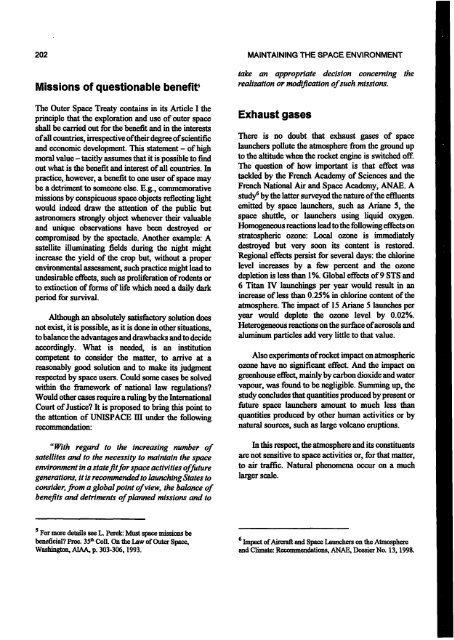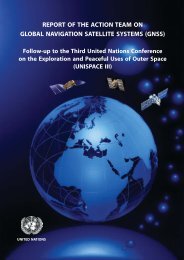Proceedings of the Workshop - United Nations Office for Outer ...
Proceedings of the Workshop - United Nations Office for Outer ...
Proceedings of the Workshop - United Nations Office for Outer ...
- No tags were found...
Create successful ePaper yourself
Turn your PDF publications into a flip-book with our unique Google optimized e-Paper software.
202 MAINTAINING THE SPACE ENVIRONMENTMissions <strong>of</strong> questionable benefit5The <strong>Outer</strong> Space Treaty contains in its Article I <strong>the</strong>principle that <strong>the</strong> exploration and use <strong>of</strong> outer spaceshall be carried out <strong>for</strong> <strong>the</strong> benefit and in <strong>the</strong> interestso f all countries, irrespective <strong>of</strong> <strong>the</strong>ir degree <strong>of</strong> scientificand economic development. This statement - <strong>of</strong> highmoral value - tacitly assumes that it is possible to findout what is <strong>the</strong> benefit and interest o f all countries. Inpractice, however, a benefit to one user <strong>of</strong> space maybe a detriment to someone else. E.g., commemorativemissions by conspicuous space objects reflecting lightwould indeed draw <strong>the</strong> attention o f <strong>the</strong> public butastronomers strongly object whenever <strong>the</strong>ir valuableand unique observations have been destroyed orcompromised by <strong>the</strong> spectacle. Ano<strong>the</strong>r example: Asatellite illuminating fields during <strong>the</strong> night mightincrease <strong>the</strong> yield <strong>of</strong> <strong>the</strong> crop but, without a properenvironmental assessment, such practice might lead toundesirable effects, such as proliferation <strong>of</strong> rodents orto extinction <strong>of</strong> <strong>for</strong>ms <strong>of</strong> life which need a daily darkperiod <strong>for</strong> survival.Although an absolutely satisfactory solution doesnot exist, it is possible, as it is done in o<strong>the</strong>r situations,to balance <strong>the</strong> advantages and drawbacks and to decideaccordingly. What is needed, is an institutioncompetent to consider <strong>the</strong> matter, to arrive at areasonably good solution and to make its judgmentrespected by space users. Could some cases be solvedwithin <strong>the</strong> framework <strong>of</strong> national law regulations?Would o<strong>the</strong>r cases require a ruling by <strong>the</strong> InternationalCourt <strong>of</strong> Justice? It is proposed to bring this point to<strong>the</strong> attention o f UNISPACE III under <strong>the</strong> followingrecommendation:“With regard to <strong>the</strong> increasing number o fsatellites and to <strong>the</strong> necessity to maintain <strong>the</strong> spaceenvironment in a state fit fo r space activities o f futuregenerations, it is recommended to launching States toconsider, from a global point o f view, <strong>the</strong> balance o fbenefits and detriments o f planned missions and totake an appropriate decision concerning <strong>the</strong>realization or modification o f such missions.Exhaust gasesThere is no doubt that exhaust gases o f spacelaunchers pollute <strong>the</strong> atmosphere from <strong>the</strong> ground upto <strong>the</strong> altitude when <strong>the</strong> rocket engine is switched <strong>of</strong>f.The question <strong>of</strong> how important is that effect wastackled by <strong>the</strong> French Academy <strong>of</strong> Sciences and <strong>the</strong>French National Air and Space Academy, ANAE. Astudy6 by <strong>the</strong> latter surveyed <strong>the</strong> nature <strong>of</strong> <strong>the</strong> effluentsemitted by space launchers, such as Ariane 5, <strong>the</strong>space shuttle, or launchers using liquid oxygen.Homogeneous reactions lead to <strong>the</strong> following effects onstratospheric ozone: Local ozone is immediatelydestroyed but very soon its content is restored.Regional effects persist <strong>for</strong> several days: <strong>the</strong> chlorinelevel increases by a few percent and <strong>the</strong> ozonedepletion is less than 1%. Global effects o f 9 STS and6 Titan IV launchings per year would result in anincrease o f less than 0.25% in chlorine content <strong>of</strong> <strong>the</strong>atmosphere. The impact o f 15 Ariane 5 launches peryear would deplete <strong>the</strong> ozone level by 0.02%.Heterogeneous reactions on <strong>the</strong> surface <strong>of</strong> aerosols andaluminum particles add very little to that value.Also experiments o f rocket impact on atmosphericozone have no significant effect. And <strong>the</strong> impact ongreenhouse effect, mainly by carbon dioxide and watervapour, was found to be negligible. Summing up, <strong>the</strong>study concludes that quantities produced by present orfuture space launchers amount to much less thanquantities produced by o<strong>the</strong>r human activities or bynatural sources, such as large volcano eruptions.In this respect, <strong>the</strong> atmosphere and its constituentsare not sensitive to space activities or, <strong>for</strong> that matter,to air traffic. Natural phenomena occur on a muchlarger scale.5 For more details see L. Perek: Must space missions bebeneficial? Proc. 35th Coll. On <strong>the</strong> Law <strong>of</strong> <strong>Outer</strong> Space,Washington, AIAA, p. 303-306, 1993.6 Impact <strong>of</strong> Aircraft and Space Launchers on <strong>the</strong> Atmosphereand Climate: Recommendations, ANAE, Dossier No. 13,1998.
















